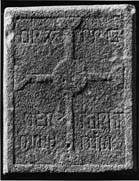Volume I: County Durham and Northumberland
Select a site alphabetically from the choices shown in the box below. Alternatively, browse sculptural examples using the Forward/Back buttons.
Chapters for this volume, along with copies of original in-text images, are available here.
Current Display: Hartlepool 04, Durham


Overview
Object type: Complete recumbent grave-marker [1]
Measurements: H. 21.6 cm (8.5 in); W. 17.1 cm (6.7 in); D. 3.5 cm (1.4 in)
Stone type: Hartlepool and Roker dolomite
Plate numbers in printed volume: Pl. 84.434-436
Corpus volume reference: Vol 1 p. 99-100
(There may be more views or larger images available for this item. Click on the thumbnail image to view.)
Present Location
Museum of Antiquities, Newcastle upon Tyne, no. 1845. 8
Evidence for Discovery
Found July 1833 '...In digging the foundations of a house belonging to Mr John Bulmer in a field called 'Cross Close' at a distance of about 135 yards from the present church-yard and in a south-easterly direction at the depth of three feet and a half and immediately upon the limestone' ((-) 1833, 218). Associated with skeletons lying roughly north-south (ibid). Early accounts agree that flat, unornamented stones, 4 to 5 inches square, were found under the heads of some skeletons, but reports vary for the 1833 group as to whether the ornamental stones were found under ((-) 1833, 218) or over (Haigh 1846, 185) the skulls.
Church Dedication
St Hilda
Present Condition
Worn
Description
The sides and back are dressed smooth.
A (broad): The face is surrounded by a flat slightly bevelled border and is quartered by a cross, type F1, in low relief. The terminals stop against the border but do not cut it and are small in relation to the central circle. There is a Latin inscription in Anglo-Saxon capitals:
(a) Upper quadrants:
ORA II PRO
(b) Lower left quadrant:
UER
M[UN]D
(c) Lower right quadrant:
[TO]RHT
[S]UID
Translation: `Pray for Vermund (sc. `and') Torhtsuid'
Discussion
The first of these two personal names is masculine, the second feminine. This raises the possibilities either that the cemetery was used by the laity, or that the religious community at Hartlepool was mixed (cf. Lindisfarne 24). The request for prayer addressed in the singular could be a petition to God or a saint. If so, the stone could have been within the grave originally, although its weathered state suggests otherwise (cf. 6).
Date
Mid seventh to mid eighth century
References
Gage 1836, pl. 52, 2; Haigh 1846, 188 and fig.; Sharp 1851, 26-33; (—) 1855a; Haigh 1858, 20 and fig.; Haigh 1875, 366-7, no. 8, pl. 2, 6; Allen and Browne 1885, 352; Pettigrew 1888, 27, fig. on 30; Allen 1889, 215-16, fig. 16; Hall 1889, 260-1; Boyle 1892, 611; Hodges 1894, 6. fig. on 4; Hodgson 1895, 205; Viëtor 1895, 18, fig. 11; Searle 1897, 458, 475; Collingwood 1903, 223 and fig.; Hodges 1905, 212-13; Hodgkin 1913, 154; Howorth 1917, I, pl. facing 94; Brown 1918-19, 201, fig. 4, 4; Brown 1921, 65, pl. 6; Peers 1923, 258-9, pl. 49, 1; Friesen 1933, 51, 59; Scott 1956, 201; Okasha 1971, 77, pl. 46; Cramp and Miket 1982, no. 53
Endnotes
1. The following are general references to the Hartlepool stones: Charlton 1855-7, 70-1; Haigh 1873, 269; Smith and Cheetham 1880, 1979; Stephens 1884a, 189; Allen and Browne 1885, 352; Browne 1886b; 12; Howorth 1914, 47; Peers 1914-15; Clapham 1930, 75; Rivoira 1933, 153; Pfeilstűcker 1936, 127; Kendrick 1938, 110; Henry 1965, 158; Page 1973, 25.



